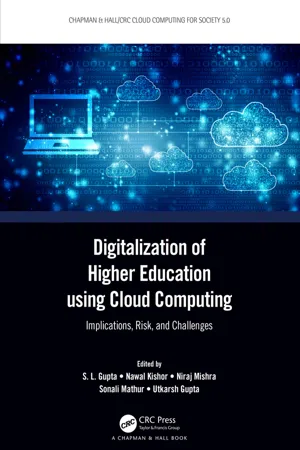
Digitalization of Higher Education using Cloud Computing
Implications, Risk, and Challenges
S. L. Gupta, Nawal Kishor, Niraj Mishra, Sonali Mathur, Utkarsh Gupta, S. L. Gupta, Nawal Kishor, Niraj Mishra, Sonali Mathur, Utkarsh Gupta
- 232 páginas
- English
- ePUB (apto para móviles)
- Disponible en iOS y Android
Digitalization of Higher Education using Cloud Computing
Implications, Risk, and Challenges
S. L. Gupta, Nawal Kishor, Niraj Mishra, Sonali Mathur, Utkarsh Gupta, S. L. Gupta, Nawal Kishor, Niraj Mishra, Sonali Mathur, Utkarsh Gupta
Información del libro
Digitalization of Higher Education using Cloud Computing: Implications, Risk, and Challenges provides an insight into the latest technology and tools being used to explore learning in Higher Educational Institutions (HEIs). Cloud computing, being an up-and-coming technology, integrates with academia and industry, thereby enhancing the quality of education.
The opportunities and challenges faced by HEIs in recent times due to technological disruptions have forced both academia and industry to realign their strategies for survival and growth. With the acceleration of cloud computing in higher education, it has now become imperative for educators to constantly upskill and reskill in order to meet the requirements of the future of work, particularly in the digital age. Technological advancement is an unstoppable wave and the lack of relevant skills to handle the disruptions in higher education will become a huge challenge if not addressed promptly. This is the new phase of Education 4.0 where HEIs are aligning themselves using cloud computing implications, and thus are preparing both faculties and students to embrace the changes happening in the teaching and learning processes.
This book focuses on multi-faceted strategies to be adopted by HEIs to deal with the emerging issues related to teaching–learning processes using cloud computing, technological interventions, curriculum overhaul, experiential learning, multi-disciplinary approaches, and continuous innovations and digitalization.
The book offers comprehensive coverage of many academic areas, with the most essential topics including:
• Pedagogies in digital education using a cloud environment
• Risks and challenges in cloud platforms for teaching and learning
• Collaborative and group learning in a cloud environment
• Enhancing quality of education using e-learning methodologies
The sections in this book are "Cloud Enabled Digitalization of Higher Education" and "Innovations and Applications of Digitalization of Higher Education: A Cloud Perspective". The book will be useful for undergraduates, graduates, academicians, scholars, and policy makers. It will help readers acquire skills for a smooth transition from face-to-face teaching to cloud-based teaching.
Preguntas frecuentes
Información
Section BInnovations and Applications of Digitalization of Higher Education: A Cloud Perspective
8Technology:Perception of Higher Education
- 8.1Introduction
- 8.2Literature Review
- 8.2.1Higher Education in India
- 8.2.2Role of Technology in Education Sector
- 8.2.3University of Delhi
- 8.2.4Image Perception and Competitive Advantage
- 8.3Methodology
- 8.3.1Research Design and Approach
- 8.3.2Research Validity and Reliability
- 8.3.3Data Collection
- 8.3.4Data Analysis
- 8.3.5Research Ethics
- 8.4Findings
- 8.4.1Students’ Issues
- 8.4.2Parents’ Issues
- 8.4.3Teachers’ Issues
- 8.4.4Administrative Issues
- 8.4.5Perception of University of Delhi
- 8.4.6Advantages at the University of Delhi
- 8.5Discussion and Conclusion
- 8.5.1Discussion
- 8.5.2Conclusion
- 8.5.3Limitations
- 8.5.4Future Scope
- References